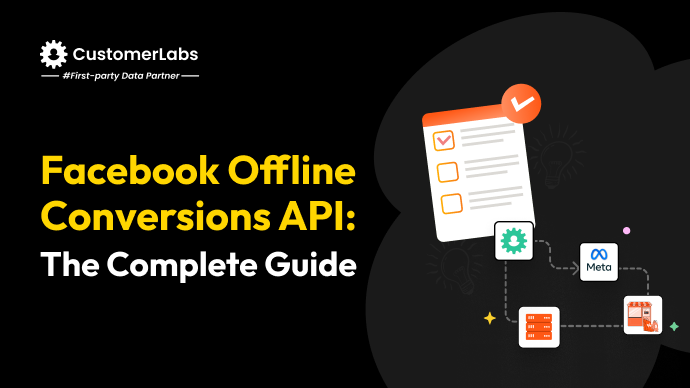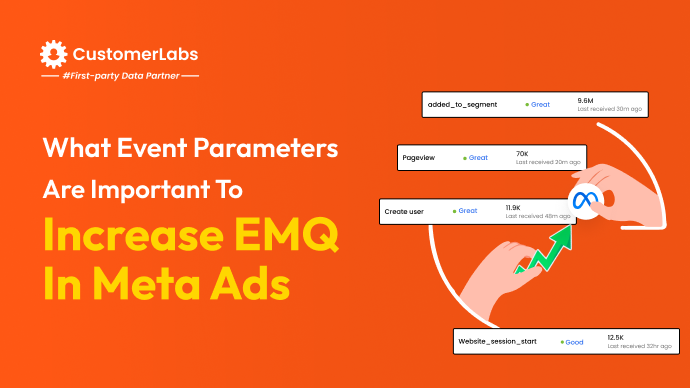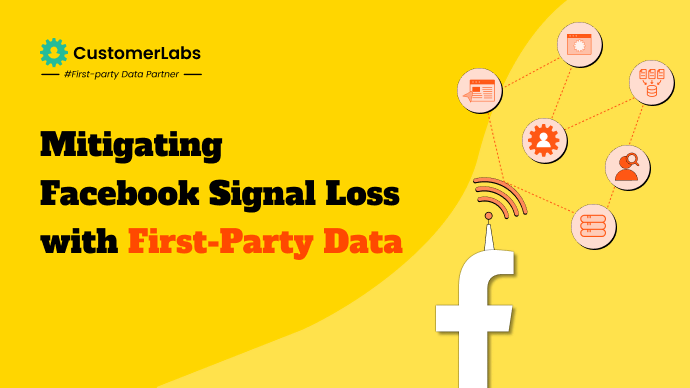You’ve probably launched your Meta Advantage+ Shopping Campaigns with high hopes, only to watch your ROAS plummet and your budget drain faster than expected.
You’re not alone.
Most ASC campaigns fail to hit their potential because advertisers jump in without understanding how these AI-driven campaigns actually work.
The biggest culprit? Treating ASC like traditional campaigns.
If you’re running e-commerce ads on Meta and want to maximize your return on ad spend, these proven strategies will help you get better results from your ASC campaigns.
First, let’s make one thing clear about Advantage+ Shopping campaigns
Why ASC campaigns often underperform?
Coming back to this statement: Treating ASC like traditional campaigns.
You might be micromanaging creative rotations, setting overly restrictive audience parameters, or spreading your budget too thin across multiple campaigns. These outdated approaches work against Meta’s machine learning algorithms, which need data and flexibility to optimize effectively.
Now, let’s have a look at the definition of ASC

Quick definition of Meta Advantage+ Shopping Campaigns (ASC)
Meta Advantage+ Shopping Campaigns are AI-powered campaigns that automatically optimize your ads across Meta’s entire ecosystem – Facebook, Instagram, Messenger, and Audience Network. This means it does not require manually setting up audiences or placements.
And this is how it works, unlike traditional campaigns. (Here’s Meta word)
ASC campaigns use Meta’s advanced machine learning to identify your best potential customers, dynamically test creative combinations, and adjust bids in real-time.
Instead of you choosing who sees your ads, the system analyzes user behavior, purchase history, and engagement patterns to deliver your products to people most likely to buy.
This automation extends to creative optimization, where the platform tests different combinations of your product images, videos, and ad copy to find winning formulas.
Meta does the majority of the job. Wondering what your job is here? And how will I control the outcome of my campaigns then?
Your part: Work with Meta’s Algorithm
How to Make the Most out of ASC?
Your ASC success depends entirely on how well you work with Meta’s algorithms, not against them.
The platform’s AI needs specific inputs to perform optimally – quality creative assets, proper data signals, and strategic campaign structure.
Without following proven best practices, you’re essentially feeding garbage data into a sophisticated system and expecting gold results.
Many advertisers see their campaigns flatline because they haven’t optimized their first-party data or are making fundamental structural mistakes.
The difference between a struggling ASC campaign and a profitable one often comes down to implementation details that seem minor but have massive performance implications.
Want to set up first-party data systems? Schedule a free consultation call.
So let’s get to the bottom of it.

12 Actionable Best Practices to improve ASC performance
1. Optimize events beyond “purchase” — use category, AOV, or custom events
Your Meta ASC optimization strategy shouldn’t revolve solely around purchase events. Smart advertisers create custom events based on specific categories, average order values, or behaviors that matter to their business.
For instance, if you sell both low-value accessories and high-value electronics, create separate optimization events for each category to help Meta’s algorithm understand which products drive the most value.
Consider setting up events for high-AOV purchases (orders over $200), specific product categories, or even customer lifetime value brackets.
This granular approach gives Meta’s machine learning more precise signals about what constitutes a valuable conversion for your business.
2. Fallback to higher-funnel events if purchase volume is too low
When your purchase volume falls below 50 conversions per week, Meta’s algorithm struggles to optimize effectively.
Instead of forcing the system to work with insufficient data, switch to higher-funnel events like “Add to Cart” or “Initiate Checkout.” These events typically occur 3-5 times more frequently than purchases, providing Meta with enough signal to optimize your Advantage+ Shopping Campaigns.
You can gradually transition back to purchase optimization once your volume increases. This approach prevents your campaigns from entering the dreaded learning-limited phase that kills performance.
3. Set up Conversions API (CAPI) to reduce signal loss
iOS updates and privacy changes have created significant tracking gaps that hurt your ASC performance.
Meta Conversion API setup becomes your safety net, capturing server-side conversion data that browsers might block.
CAPI implementation typically recovers 15-30% of lost conversion data, giving your campaigns better optimization signals. Your match rates improve, and Meta can better understand which audiences convert, leading to more efficient spending and better ROAS.

4. Pass conversion values & set realistic minimum ROAS goals
Don’t leave money on the table by failing to pass conversion values to Meta.
Your ASC campaigns need this revenue data to optimize for value, not just volume. Set your minimum ROAS target based on your actual profit margins, not arbitrary numbers you’ve seen in case studies.
If your average profit margin is 40%, setting a minimum ROAS of 4.0 ensures profitability while giving Meta enough flexibility to find profitable conversions across different price points and customer segments.

5. Plan budgets based on expected conversions (CPA × 50 per week / 7)
Your daily budget should align with Meta’s optimization requirements. Calculate your target CPA and multiply by 50, then divide by 7 to get your minimum daily budget. This ensures your campaigns generate enough conversions weekly for proper machine learning optimization.
For example, if your target CPA is $30, your minimum daily budget should be around $214 ($30 × 50 ÷ 7). Starting with inadequate budgets forces Meta to optimize with limited data, resulting in poor performance.
6. Use budget scheduling to scale spending during promotions
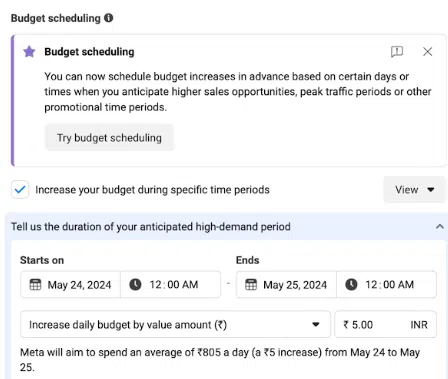
ASC budget optimization becomes critical during high-traffic periods. Use Meta’s budget scheduling feature to automatically increase spending during promotions, holidays, or known high-conversion periods.
This prevents you from missing out on profitable traffic when demand spikes.
Set up rules to increase budgets by 50-100% during promotional periods, then automatically scale back afterward. This approach maximizes revenue opportunities without manual intervention.

7. Split budget between prospecting and retargeting with caps
While ASC campaigns handle audience targeting automatically, you should still allocate budgets strategically between customer acquisition and retention.
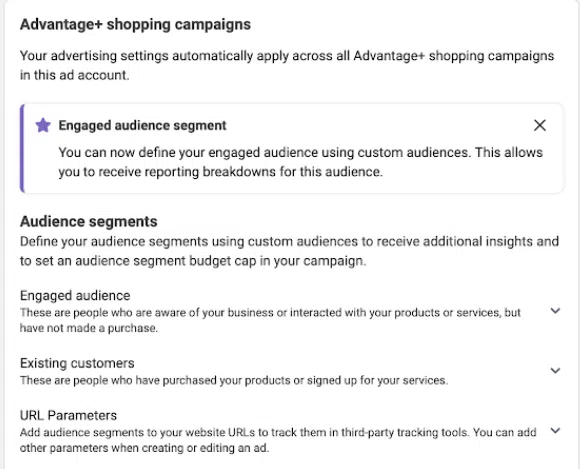
Create separate ASC campaigns for prospecting new customers and retargeting existing ones, with clear budget caps for each objective.
Typically, allocate 70% of your budget to prospecting and 30% to retargeting, adjusting based on your customer lifetime value and retention rates.
8. Create one campaign per country for better learning
Geographic performance varies significantly, and combining multiple countries in a single ASC campaign dilutes learning efficiency.
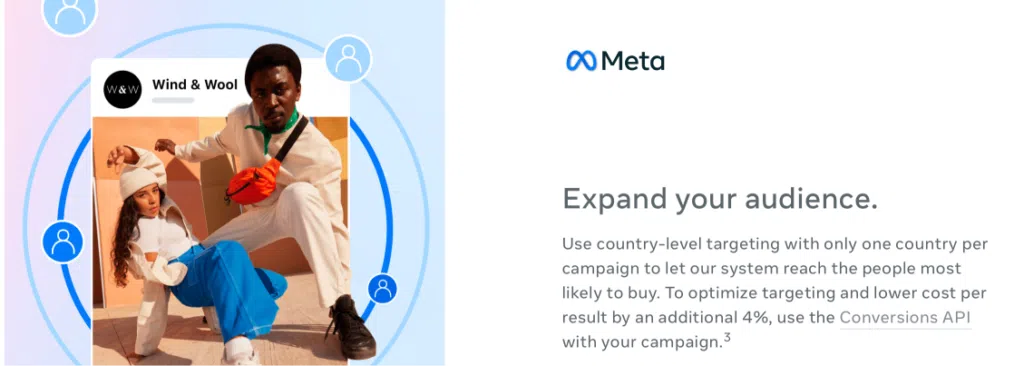
Create separate campaigns for each major market, allowing Meta’s algorithm to optimize for local preferences, behaviors, and economic conditions.
This approach improves performance consistency and makes budget allocation more transparent across different markets.
9. Apply placement exclusions at the account level for low-performing placements
Your Meta ASC best practices should include systematic placement optimization. Review performance data regularly and exclude consistently underperforming placements at the account level.
Common exclusions include Audience Network placements or specific in-stream video positions that don’t align with your product type.
Account-level exclusions apply to all campaigns automatically, saving time and ensuring consistency across your advertising efforts.
10. Provide diverse creatives (images, video, catalog, carousels)
Creative diversity drives ASC success. Upload multiple asset types—high-quality product images, lifestyle videos, user-generated content, and carousel formats.
Meta’s algorithm tests different combinations to find winning creative variations for different audience segments.
Aim for at least 5-10 images and 3-5 videos per campaign, updating them regularly to prevent creative fatigue.
11. Refresh creatives regularly to prevent fatigue
ASC creatives’ best practices include proactive creative rotation. Monitor your frequency metrics and creative performance scores, refreshing underperforming assets before they drag down campaign results.
Generally, refresh creatives every 2-4 weeks, depending on your audience size and spend levels.
Set calendar reminders to review and update creatives systematically rather than reactively responding to performance drops.
12. Run A/B tests or holdouts to compare ASC vs BAU campaigns
Validate your ASC performance by running controlled tests against traditional campaign structures. Use Meta’s holdout testing or create manual A/B tests comparing ASC performance to your standard campaigns using the same budgets and audiences.
This testing approach provides concrete data on whether ASC delivers better results for your specific business model and helps justify budget allocation decisions.
13. Use URL parameters to track new vs existing customers
Implement URL parameters to differentiate between new customer acquisitions and repeat purchases in your analytics.
This data helps you understand the true customer acquisition cost and lifetime value impact of your ASC campaigns.
Why new customer acquisition event optimization becomes clearer when you can separate new vs returning customer performance in your reporting.
14. Choose correct conversion location (web, app, or combined)
Match your conversion location setting to where your customers actually complete purchases.
If you drive traffic to your website but customers often complete purchases on your mobile app, choose “website and app” to capture the full conversion path.
Misaligned conversion location settings create attribution gaps that hurt campaign optimization and reporting accuracy.
I have given you some extra practices to try out. Now let me tell you the mistakes that you can avoid with ASC.
Common Mistakes to Avoid for ASC Campaigns
1. Frequent manual changes breaking learning
Your Meta ASC campaigns need time to learn and optimize. When you constantly make manual adjustments—tweaking budgets daily, changing audiences, or modifying creative elements—you’re essentially hitting the reset button on the algorithm’s learning process.
Meta’s machine learning requires at least 50 conversions within a week to exit the learning phase.
Every time you make significant changes, the system starts learning from scratch. This means your campaigns spend more time in the unstable learning phase rather than in the optimized delivery phase, where they perform best.
Instead of making daily tweaks, give your campaigns at least 3-7 days to stabilize before evaluating performance. If you must make changes, do them gradually and sparingly. Focus on major performance indicators rather than day-to-day fluctuations.
2. Too many small campaigns instead of consolidated ones
Running multiple small-budget ASC campaigns fragments your data and limits the algorithm’s ability to find optimal audiences and placements. When you spread your budget across numerous campaigns, each one has insufficient data to learn effectively.
Meta ASC works best with consolidated budgets that allow for proper machine learning. A single campaign with $100 daily budget will typically outperform five campaigns with $20 each because the larger campaign has more conversion data to optimize against.
Consolidate your campaigns by combining similar products or audiences into fewer, well-funded campaigns. This approach gives Meta more room to test different placements and audiences while maintaining statistical significance in your results.
3. Unrealistic ROAS or budget goals
Setting overly ambitious ROAS targets or inadequate budgets creates a recipe for campaign failure.
If you’re expecting a 10x ROAS from day one or running campaigns with $10 daily budgets while expecting significant results, you’re setting yourself up for disappointment.
Your budget should align with your conversion volume needs. Meta recommends at least 50 conversions per week per ad set for optimal learning.
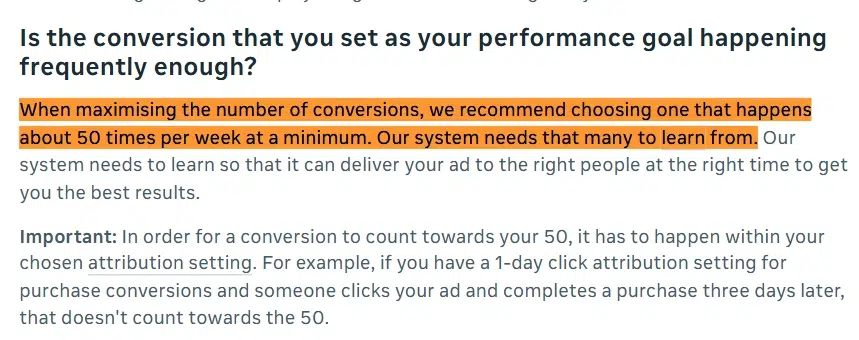
If your average order value is $50 and you’re targeting a 4x ROAS, you need enough budget to generate meaningful conversion volume.
Start with realistic ROAS expectations based on your historical performance and gradually optimize upward. Similarly, ensure your daily budget can support the conversion volume needed for effective learning.
4. Ignoring creative fatigue
Creative fatigue happens when your audience sees the same ads repeatedly, leading to decreased engagement and higher costs. Many advertisers focus solely on targeting and bidding while neglecting creative performance metrics.
Monitor your creative frequency and engagement rates closely. When you notice declining click-through rates or increasing cost per result, it’s time to refresh your creative assets.
Meta campaign optimization with first-party data can help you identify which creatives resonate best with different audience segments.
Prepare multiple creative variations before launching your campaigns. Test different formats—videos, carousels, single images—and rotate them based on performance. Keep your creative pipeline full with fresh assets to prevent fatigue from hurting your campaign performance.
Up next are some real-life cases that aced ASC.
Case Studies: Real Results from Meta ASC Best Practices
The brand names are not mentioned due to NDA. And I have written key lesson by the end of every case study, so that you can understand it clearly.
Case Study 1: E-commerce Fashion Brand Doubles ROAS with Budget Optimization
A mid-sized fashion retailer was struggling with their Meta ASC performance, seeing a disappointing 1.8 ROAS despite decent traffic. Their campaign was spread across three ad sets with $50 daily budgets each, competing against each other for the same audience.
By consolidating into a single Advantage+ Shopping Campaign with a $150 daily budget, they immediately saw improvements. The unified budget allowed Meta’s algorithm to find the best-performing placements and audiences without internal competition. Within 30 days, their ROAS jumped to 3.2, and their cost per acquisition dropped by 35%.
Key lesson: Your budget consolidation strategy can make or break campaign performance. Multiple small budgets fragment your data and limit algorithmic learning.
Case Study 2: Home Goods Store Achieves 4x Growth with Creative Testing
A home decor brand was running the same static product images for months, wondering why their Meta ASC campaigns were stagnating. Their conversion rate was stuck at 1.2%, and they weren’t seeing the scale they needed.
They implemented a systematic creative testing approach, introducing video content showcasing products in real home settings, user-generated content, and carousel formats highlighting product collections. They also started refreshing creative assets every 2-3 weeks to combat ad fatigue.
The results were dramatic: their conversion rate improved to 3.8%, and overall campaign performance increased by 300%. The video content particularly resonated, generating 60% of their conversions despite being only 40% of their creative mix.
Key lesson: Static product shots won’t cut it anymore. Your creative strategy needs variety, authenticity, and regular refreshment to keep Meta ASC performance strong.
Case Study 3: Tech Accessories Brand Leverages First-Party Data for 40% Cost Reduction
A smartphone accessories company was relying entirely on Meta’s broad targeting, resulting in high costs and low-quality traffic. Their customer acquisition costs were climbing, and they weren’t seeing repeat purchases from their Meta ASC traffic.
They implemented first-party data optimization by creating custom audiences from their email subscribers and website visitors. They also set up proper conversion tracking to feed high-quality signal back to Meta’s algorithm.
The transformation was remarkable: their cost per acquisition dropped by 40%, and the quality of customers improved significantly, with 25% higher lifetime value compared to their previous broad-targeting approach.
Key lesson: Your first-party data is gold for Meta ASC optimization. Don’t let Meta guess who your ideal customers are when you already know.
Case Study 4: Supplement Brand Overcomes iOS 14.5 Challenges with Enhanced Tracking
A health supplement company saw their Meta ASC performance plummet after iOS 14.5 updates. Their attribution was broken, and they couldn’t properly track conversions, leading to poor algorithmic optimization and wasted ad spend.
They implemented enhanced conversion tracking through server-side tracking and Conversions API setup. This gave them cleaner data signals and better attribution modeling. They also extended their conversion window to account for longer consideration periods in their industry.
Within 60 days, their campaign performance recovered and exceeded pre-iOS 14.5 levels. Their ROAS improved from 2.1 to 4.5, and they gained confidence in their attribution data for better decision-making.
Key lesson: Proper tracking setup isn’t optional—it’s the foundation that determines whether your Meta ASC optimization efforts will succeed or fail.
To wind up, let me help you with how you can implement your first-party data setup to improve your ASC performance
Implementation Roadmap to Fix to ASC
Step 1: Fix data & signals
- Your first priority should be establishing clean, reliable data flow between your Shopify store and Meta. Without proper data signals, your Meta ASC campaigns will struggle to find the right customers and optimize effectively.
- Start by implementing the Meta Conversion API alongside your Facebook Pixel. This dual setup ensures you capture every conversion event, even when iOS 14.5+ blocks traditional pixel tracking. Set up server-side tracking for critical events like purchases, add-to-cart, and checkout initiation.
- Focus on sending high-quality first-party data to Meta. Upload your customer email lists, phone numbers, and purchase history through the Conversions API. Why you should optimize Meta Ads with First-Party Data explains how this approach cuts through the noise and improves campaign precision significantly.
- Verify your product catalog is properly synced and up-to-date. Remove out-of-stock items, fix pricing discrepancies, and ensure product images meet Meta’s quality standards. Your catalog should refresh automatically every few hours to prevent promoting unavailable products.
Step 2: Optimize campaign structure & budget
- Once your data foundation is solid, restructure your Meta ASC campaigns for maximum efficiency. Create separate campaigns for different product categories or customer intent levels rather than throwing everything into one massive campaign.
- Set your initial daily budget at 10-15x your target cost per acquisition. Meta’s algorithm needs sufficient budget to explore different audiences and optimize effectively during the learning phase. Starting too low restricts the algorithm’s ability to find profitable customers.
- Choose the right campaign objective based on your business goals. For most e-commerce brands, the “Sales” objective with “Purchase” optimization works best. Avoid switching objectives frequently, as this resets the learning phase and hurts performance.
- Configure your audience settings properly. While ASC campaigns use broad targeting, you can still exclude customers who purchased in the last 30 days to focus on new customer acquisition. Set appropriate age ranges and geographic boundaries that align with your shipping capabilities.
Step 3: Scale creatives & testing
- Your creative strategy makes or breaks your Meta ASC performance. Start with 3-5 high-quality video ads and 3-5 static image ads per campaign. Focus on user-generated content, product demonstrations, and lifestyle imagery that showcases your products in action.
- Develop a systematic testing approach. Test one variable at a time – whether it’s the hook, visual style, or call-to-action. Give each creative at least 5-7 days and $200-300 in spend before making decisions. Don’t kill creatives too early based on initial metrics.
- Create variations of your winning ads by changing the opening hook, background music, or text overlay. Sometimes small tweaks can dramatically improve performance. Keep a content calendar to ensure you’re constantly feeding fresh creatives into your campaigns.
- Monitor your frequency metrics closely. When your average frequency hits 2.5-3.0, it’s time to introduce new creatives or refresh existing ones. High frequency leads to ad fatigue and declining performance.
Step 4: Refine tracking & attribution
- Your final step involves fine-tuning your measurement and attribution setup to get accurate performance data. Set up proper UTM parameters for all your campaigns to track traffic sources in Google Analytics alongside Meta’s reporting.
- Configure your attribution window based on your customer journey length. For most e-commerce brands, a 7-day click and 1-day view attribution window provides the most accurate picture without over-attributing to Meta.
- Implement post-purchase surveys to understand how customers actually discovered your brand. Often, the attribution path is more complex than what platforms report. This data helps you allocate budget more effectively across channels.
- Set up automated reports that combine data from multiple sources – Meta Ads Manager, your Shopify analytics, and customer surveys. This holistic view helps you make better optimization decisions and understand the true impact of your Meta ASC campaigns.
- Regular weekly reviews of your attribution data will help you spot trends early and adjust your strategy accordingly. Look for patterns in customer behavior, seasonal fluctuations, and the relationship between your ASC performance and overall business metrics.
Conclusion
I’ll give you this one formula for ASC,
Strong Inputs (First-party data) + Patience = ASC Success
The most successful Meta ASC campaigns share two common elements: quality inputs and patience during the optimization process.
Your first-party data plays a crucial role in providing quality inputs. Patience becomes your competitive advantage in a world where advertisers constantly tweak and adjust their campaigns. ASC algorithms need time to learn and optimize.
This gradual approach allows you to measure the impact of each change and prevents you from disrupting campaigns that are already working well. Track your key metrics before and after each modification to understand what moves the needle for your specific business.
Consider working with specialists who can identify optimization opportunities you might miss.
Start your first-party data setup for free from scratch. If you want clarity, talk to us for expert guidance.
Sometimes an outside perspective reveals simple adjustments that can significantly improve your Meta ASC performance while you maintain focus on other aspects of your business growth.
